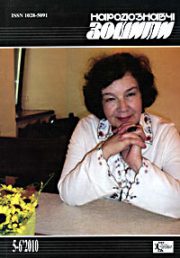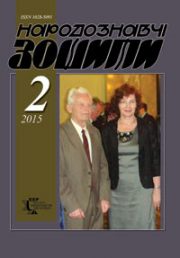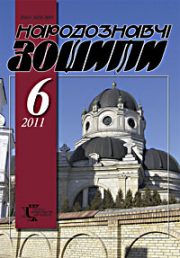The Ethnology Notebooks. 2022. № 5 (167), 1194—1202
UDK 72.012.1:[747:647.53:39]”20″
DOI https://doi.org/10.15407/nz2022.05.1194
ETNOSTYLISTICS IN DESIGN RESIDENTIAL INTERIOR
BOYKO Khrystyna
- ORCID ID: https://orcid.org/0000-0002-4889-8337
- Ph. D. in Architecture, Associate Professor
- of the Department of Design and Fundamentals
- of Architecture of the Lviv Polytechnic National University
- 12, S. Bandera Street, 79000, Lviv, Ukraine,
- Contacts: e-mail: khrystyna.boyko@hotmail.com
RADOMSKA Violetta
- ORCID ID: https://orcid.org/0000-0001-6868-868X
- Candidate of Art History (Ph. D.), Senior Lecturer
- of the Department of Design and Fundamentals
- of Architecture of the Lviv Polytechnic National University,
- 12, S. Bandera Street, 79000, Lviv, Ukraine,
- Contacts: e-mail: w.r.radomska@gmail.com
Abstract. Problem statement. The article focuses on the problem of applying visual and stylistic identifiers to create harmonious residential space in the design education system of the XXI century. It delves into the role of ethno-oriented direction of interior stylization which is based on interpreting the archetypes of folk art and their modern transformation that is actively gaining relevance and ensures qualitative formation and revival of identification within the creative aspect of modern architectural and design practice in Ukraine. Purpose. The purpose of the article is to outline the major directions and methodologies of applying ethostylistics to residential space design. The object of research is the experience of applying ethnostylistics to modern residential interior. The subject of research is constituted by the project design works of students of the specialty «Design» at the Department of Design and Architecture Fundamentals, Lviv Polytechnic National University. The source base includes literary publications, scientific publications, archival graphic projects of students of the Department of Design and Architecture Fundamentals. Methods. The methodological basis of the article is based on the historical and systemic principle with the application of the methods of analysis, statistics, comparison, and generalization. Results. As per the outlined purpose, we have analyzed the experience of practical application of the wide spectrum of stylistic identifiers, in particular, the prolific achievements of the world and Ukrainian ethostylistics in creating spaces that have different functional intention. The specificity of application and formation of the algorithm of methodological consistency in determining stylistic identifiers in residential interior has been scrutinized, since the specified direction in project design ensures the opportunity of creating an individual project work. Conclusion. The selected aspects of folk household routine, regional peculiarities, differences, customs, coloristics, shape formation and ornamentation, and cultural peculiarities of certain ethnicity are directly interconnected with aesthetic object-spatial decoration of individual residential buildings. The above enlisted characteristics can be integrated into the conceptual structure of interior design and constitute the generative instrument for reinforcing tendencies in the individual personified centers of Ukrainian design schools and in the educational process of the specialty 022 «Design».
Keywords: identification, ethnostylistics, interpretation, transformation, interior, project design, residential space.
Received 6.09.2022
REFERENGES
- 1. Sokoliuk, L. (2012). Ways of Ukrainian design creation. Sketches on history of Ukrainian design of the XX century (Pp. 84—110). Kyiv: FENIKS [in Ukrainian].
- Shmahalo, R. (2020). Ideological and philosophical origins of art and design education in the epoch of modernism and postmodernism. Topical problems of modern design. (Proceedings of the International Scientific and Practical Conference). Kyiv: KNUTD [in Ukrainian].
- Antonovych, Ye.A., Zakharchuk-Chuhai, R.V. & Stankevych, M.Ye. (1992). Decorative and applied art. Lviv: Svit [in Ukrainian].
- Dyda, I.A. (2009). Ecological fundamentals of traditional Ukrainian architecture: Monograph. Lviv: Publishing House of Lviv Polytechnic National University [in Ukrainian].
- Snizhko, V.V. (2011). Ethno-design as Ukrainian worldview structure. Nauka i Suspilstvo (Pp. 30—36) [in Ukrai nian].
- Cherkes, B.S. (2008). National identity in city architecture: Monograph. Lviv: Publishing House of Lviv Polytechnic National University [in Ukrainian].
- Bachynska, L.H. (2016). Residential buildings architecture in Ukraine in the middle of the XX—XXI centuries (historical and analytical sketch). Kyiv:KNUBA [in Ukrainian].
- Oliinyk, O.P., Hnatiuk, L.R. & Cherniavskyi, V.H. (2008). Interior design fundamentals. Kyiv: Dovira [in Ukra inian].
- Siomha, S., & Antonovych, Ye. (2018). Design of interior, furniture, and equipment. Kyiv: Lira [in Ukrainian].
- Zymina, S.B. (2017). Stylistic peculiarities of organic and ecological interiors. Modern problems of architecture and urban planning, 47, 71—88 [in Ukrainian].
- Zymina, S.B. (2017). Ukrainian ethnic style and its reflection in other interior styles. Architectural herald of KNUBA, 55, 54—69 [in Ukrainian].
- Yurchenko, I. (2011). Hutsul carving. Visual and morphological ornament patterns: theory and practice. Lviv: Publishing House of Lviv Polytechnic National University [in Ukrainian].
- Dyda, I., & Radomska, V. (2020). Stylistic peculiarities in interior design. Lviv: Publishing House of Lviv Polytechnic National University [in Ukrainian].







